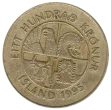Exchange your Icelandic Kronur
Do you have leftover Icelandic Kronur? We offer a fast and easy way to exchange current and withdrawn Icelandic Kronur banknotes and coins. Convert them into your local currency today with our quick and hassle-free exchange service.
kr - ISK
The Icelandic Krona has been in use since 1874 and remains a vital part of Iceland’s economic system.
Icelandic Kronur Information
The Icelandic Krona (ISK) is the official currency of Iceland, an island nation located in the North Atlantic. The Krona was introduced in 1874, replacing the Danish rigsdaler, as Iceland moved toward economic independence from Denmark. Over the years, the Icelandic Krona has been an integral part of Iceland’s financial system, reflecting the country’s unique position as a small but resilient economy with strong ties to fishing, renewable energy, and tourism.
The Icelandic Krona is subdivided into 100 aurar, although aurar coins are no longer in circulation due to inflation. Coins are available in 1, 5, 10, 50, and 100 kronur denominations, while banknotes are issued in 500, 1,000, 2,000, 5,000, and 10,000 kronur denominations. The designs on Icelandic banknotes and coins often feature important historical figures, national symbols, and depictions of Iceland’s natural beauty, including images of glaciers, volcanoes, and wildlife.
Iceland’s economy is heavily reliant on industries such as fishing, renewable energy, and tourism, all of which contribute to the country’s GDP and economic growth. The stability of the Icelandic Krona has been essential in supporting these industries, particularly in the face of global economic challenges. One of the defining features of the Icelandic economy is its use of renewable energy, primarily geothermal and hydropower, which has allowed Iceland to maintain a high standard of living.
However, the Icelandic Krona has also faced periods of instability, particularly during the global financial crisis of 2008. Iceland’s banking sector was hit hard by the collapse of major financial institutions, leading to a significant depreciation of the Krona and a sharp increase in inflation. In response, the Icelandic government implemented a range of economic reforms and currency controls to stabilise the economy and restore confidence in the Krona.
The Central Bank of Iceland is responsible for issuing the Icelandic Krona and managing the country’s monetary policy. The central bank’s primary objective is to maintain price stability and low inflation, which are crucial for preserving the currency’s value. In recent years, Iceland has made significant progress in modernising its financial system, and the stability of the Krona has played a key role in attracting foreign investment and promoting economic recovery.
Despite its small size, Iceland’s economy remains highly integrated with the global economy, and the Icelandic Krona is widely used for domestic and international transactions. The currency is significant in supporting Iceland’s growing tourism sector, which has become one of the most significant contributors to the country’s GDP in recent years. The resilience of the Icelandic Krona, combined with the country’s focus on sustainable development, ensures that it will continue to play a central role.
In conclusion, the Icelandic Krona has been Iceland’s official currency since 1874. It remains a stable and resilient currency, reflecting the country’s economic strength and its focus on sustainability and innovation.


